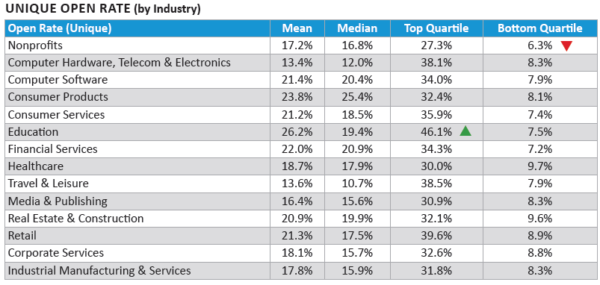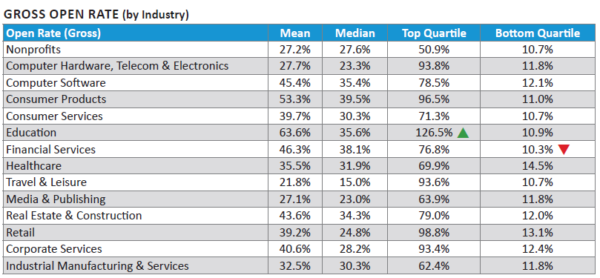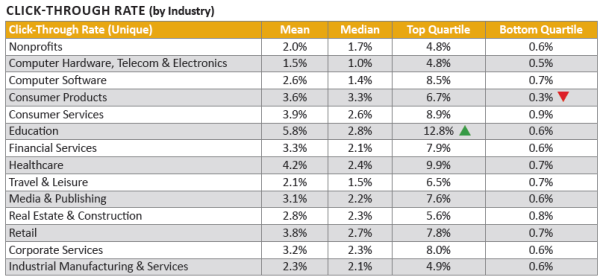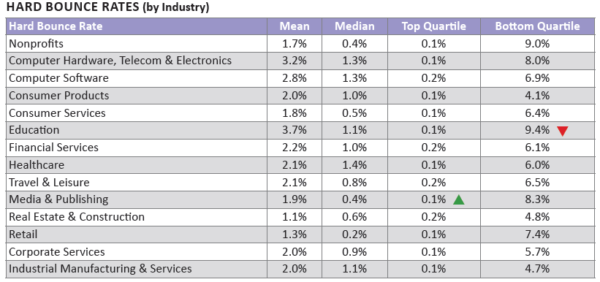Email Marketing Metrics Study Identifies Top Performers & Sets Industry Benchmarks
Email marketing automation provider Silverpop released its 2013 Email Marketing Metrics Benchmark study, analyzing key metrics of fourteen different industries in the U.S. and Canada, as well as countries in Europe, the Middle East, Africa and Asia Pacific. When evaluating open rates, CTRs, CTORs and list churn statistics, the top performing vertical industries included education, […]
Email marketing automation provider Silverpop released its 2013 Email Marketing Metrics Benchmark study, analyzing key metrics of fourteen different industries in the U.S. and Canada, as well as countries in Europe, the Middle East, Africa and Asia Pacific. When evaluating open rates, CTRs, CTORs and list churn statistics, the top performing vertical industries included education, computer hardware, telecom and electronics, and retail.
While the study did not uncover any unexpected metrics, it does offer a series of benchmarks for email marketers to use as a measuring stick against their own email marketing results.
Open Rates
Consumer product emails scored the highest for open rates with a median 25.4 percent success rate. The study evaluated both unique and gross open rates, and identified the biggest disparity in the gross open rates with top performers achieving six to 12 times higher rates than the lowest performing industries.
The study also examined opens-per-opener rates, a lesser used metric that measures how many times email recipients open the same message. Consumer products ranked highest in this category with a 2.98 percent opens-per-opener rate.
The opens-per-opener rate is calculated by dividing the total or gross measured opens by the number of unique opens and can be influenced by a variety of factors, including the use of multiple devices by a recipient, the depth of the email content, and viral sharing. (The study noted that emails sent using the “forward” link in an email software client are associated with the original recipient, versus emails sent via the “forward-to-a-friend” link within an email which are calculated independently.)
Click-Through-Rates
Of all the metrics evaluated, CTRs illustrated the greatest divide between the top and bottom performing industries, with education, healthcare, retail and consumer products/services ranking the highest of the 14 industries. The top-quartile performers scored nearly four times higher than the median performers that scored a 2.3 percent CTR, while the lowest performing industries registered less than a 1 percent CTR.
Click-To-Open Rates
CTORs, the ratio of unique clicks as a percentage of unique opens, were similar to the CTR results, with top performing industries experiencing rates nearly double those of the median performers, and three times the rate of the bottom performers. The healthcare industry scored highest in this category with the top quartile performers achieving a 33 percent CTOR.
List Churn Metrics
Hard bounce rates and unsubscribes highlight the key differences between the top and bottom performers in the study. Few things impact a successful email marketing program more than a company’s list management processes. The results of Silverpop’s study only reinforce this fact by demonstrating how high bounce rates are a common occurrence among the lowest-performing email marketers.
While top performers received less than a 1 percent bounce rate, low performers experienced close to a 10 percent bounce rate.
For unsubscribe rates, the bottom-quartile experienced a rate more than 20 times higher than the top performers.
To conduct the study, Silverpop evaluated emails sent by 2,787 brands from 40 different countries throughout 2012. All emails were sent by Silverpop’s Engage client base, and included a broad set of message types, from promotional emails and content-based newsletters to notifications and transactional messages.
Contributing authors are invited to create content for MarTech and are chosen for their expertise and contribution to the martech community. Our contributors work under the oversight of the editorial staff and contributions are checked for quality and relevance to our readers. The opinions they express are their own.
Related stories
New on MarTech





